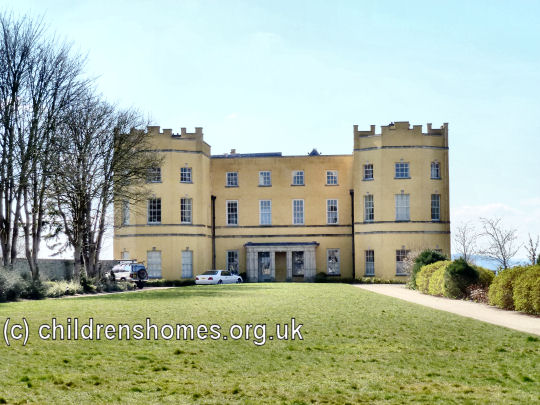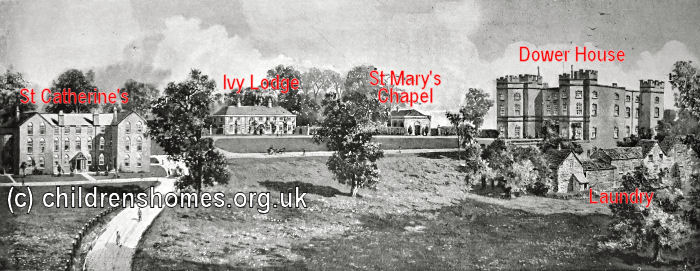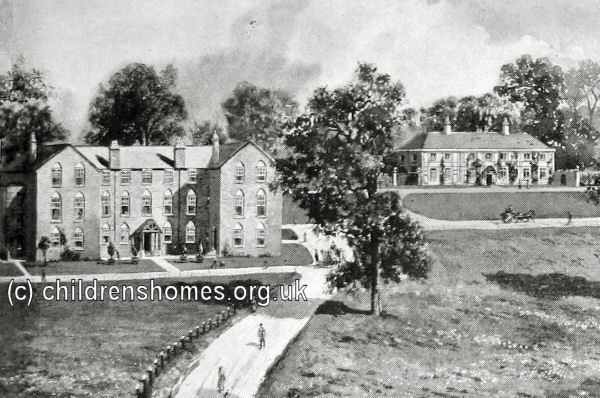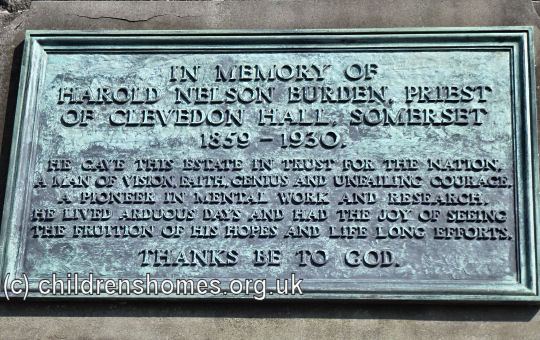Stoke Park Colony for Mentally Defective Children, Bristol, Gloucestershire
The Stoke Park Colony for Mentally Defective Children, near Stapleton, Bristol, was established in 1909 by the Rev Harold Nelson Burden and his first wife, Katherine.
In the 1890s, the Burdens had become involved in working with inebriates in Bristol and set up The Royal Victoria Home for Women. Following the 1898 Inebriates Act, which enabled the compulsory detention of convicted drunkards in inebriate reformatories, the Burdens had led the creation of the National Institutions for Inebriates which operated a number of establishments including the Southern Counties Reformatory at Lewes and the Eastern Counties Reformatory at East Harling, both based in former workhouse buildings.
By 1907, committals to inebriate reformatories were in sharp decline and the Burdens had begin to turn their attention to institutions for housing people with severe learning difficulties, what were then referred to as 'mental defectives'. The first of their new establishments was opened at Sandwell Hall, near West Bromwich.
After Sandwell Hall was fully occupied, the Burdens leased the Dower House and some surrounding land at Stoke Park in Stoke Gifford, near Bristol. On April 14th, 1909, the premises were certified to accommodate 90 girls, the first of whom arrived eight days later.

Dower House from the north-east, former Stoke Park Colony, Bristol, 2013. © Peter Higginbotham
The accommodation was rapidly expanded with new buildings. A block known as Ivy Lodge was erected to house 90 boys under 16 and received its own certification on July 20, 1909. While the younger girls continued to live in the Dower House, the St Catherine's building was used for those over 16. On November 16, 1911, the site's accommodation for girls was set at 365 places.

Stoke Park Colony from the north-west, Bristol, c.1911. © Peter Higginbotham

Stoke Park Colony from the north-west, Bristol, c.1911. © Peter Higginbotham
The growing accommodation is described in the 1911 report extracts below:
- Dower House — an old family mansion acquired with the estate. Presently empty to enable extensive alterations to be made.
- St Catherine's Blocks, North and South — a recently constructed section, consisting of two three-storey buildings of red brick, connected with each other by a well-equipped administrative block containing kitchen, dining-room, store, and ablution-rooms. The whole provide accommodation for 275 female patients, allowing 600 cubic feet per bed; is of modern design, efficiently ventilated, steam-heated, and well lit.
- Ivy Lodge — a convenient and comfortable detached block, cleverly constructed out of stables originally belonging to the property, and contains accommodation for 90 male patients, with 600 cubic feet per bed.
- The Hospital — equipped with 55 beds, is now being extended, and will in course of time provide space for a further 100 beds. It possesses, in addition to ordinary wards, an extensive open-air veranda overlooking the park. Five double-bedded open-air revolving shelters are also attached to the hospital for summer use.
- A Detached Chapel — with a large room adjoining which can be connected for chapel use (and so facilitate the separation of the sexes) or be disconnected for school, recreation, or amusement purposes.
- Workrooms — fitted with looms, rug-making frames, and other facilities for industry.
- Laundry — less satisfactory than the rest of the institution, but good enough for immediate use. Shortly to be replaced by a newly-constructed modern substitute.
The layout of the site in 1935 is shown on the map below.

Stoke Park Colony for Mentally Defective Children site, Bristol, c.1935.
In 1913, the Burdens set up a trust known as the National Institutions for Persons Requiring Care and Control (NIPRCC) to take over the formal ownership of their various institutions which had by now all converted from inebriate reformatories to ones housing mental defectives.
The Stoke Park Colony continued to expand, with other properties in the area being bought or leased, including Leigh Court at the other side of Bristol, and Hanham Hall. In 1914, they purchased Clevedon House as their own residence although part of it was used as a holiday home accommodation for the Colony. By 1917, Stoke Park's accommodation totalled 1528 places.
Katherine Burden died in 1919. The following year, he married Rosa Gladys Williams, who had been superintendent matron of Stoke Park since 1914. After Harold Burden's death in 1930, Rosa continued the work of the NIPRCC until her own death in 1939. Harold and Rosa are commemorated on the clock tower at the centre of the Colony site.

Clock tower, former Stoke Park Colony, Bristol, 2013. © Peter Higginbotham

Memorial plaque, former Stoke Park Colony, Bristol, 2013. © Peter Higginbotham

Memorial plaque, former Stoke Park Colony, Bristol, 2013. © Peter Higginbotham
Former Stoke Park Colony chapel.
The role of Stoke Park as an Industrial School ceased in 1932.
After 1948, the site became part of the new National Health Service as Stoke Park Hospital. The Hospital closed in 1997 and most of the buildings were demolished to make way for modern housing. The Dower House, chapel and clock tower still survive.
In his will, Harold Burden established the Burden Trust, still in operation today, to support those in need n ways that were similar to the causes that he had championed during his lifetime.
Records
Note: many repositories impose a closure period of up to 100 years for records identifying individuals. Before travelling a long distance, always check that the records you want to consult will be available.
- Bristol Record Office, 'B' Bond Warehouse (in the 'Create Centre' section from 3-Dec-2013), Smeaton Road, Bristol BS1 6XN. Has a variety of material including: Female admission registers (1914-48); Male admission registers (1914-48); Registers of Removals, Discharges and Deaths (1914-48); Registers of Mechanical Restraint and Seclusion (1915-65); General registers (1948-1987, includes many pre-1948 entries); Boys at Stoke Park Colony (c.1943-50); Girls at Stoke Park Colony (c.1943-50).
Bibliography
- Carpenter, Peter K Rev Harold Nelson Burden and Katherine Mary Burden: pioneers of inebriate reformatories and mental deficiency institutions (J R Soc Med 1996;89:205-209)
- Higginbotham, Peter Children's Homes: A History of Institutional Care for Britain's Young (2017, Pen & Sword)
- Mahood, Linda Policing Gender, Class and Family: Britain, 1850-1940 (1995, Univeristy of Alberta Press)
- Prahms, Wendy Newcastle Ragged and Industrial School (2006, The History Press)
Links
Except where indicated, this page () © Peter Higginbotham. Contents may not be reproduced without permission.


